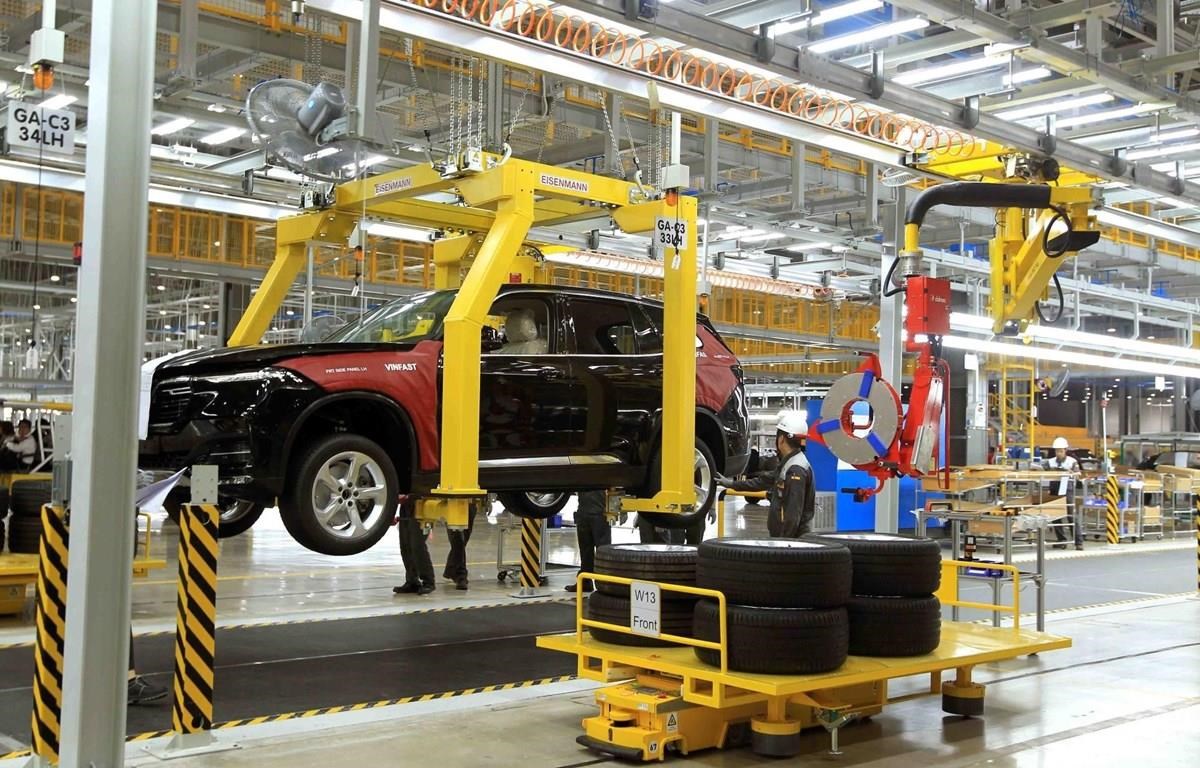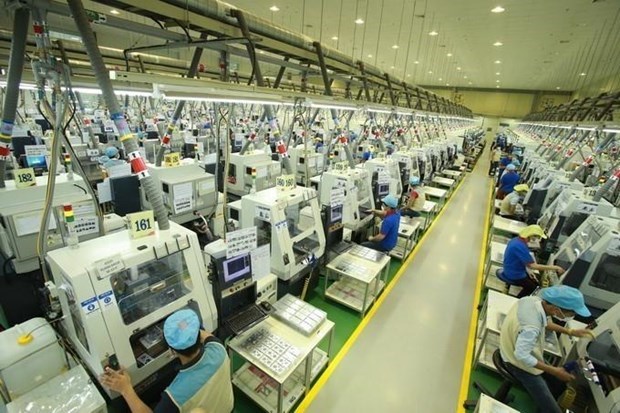Much needs to be done to attract new-generation FDI capital
Vietnam is making a strategy for attracting “new-generation” foreign direct investment (FDI) so as to promote extensive economic growth between 2020 and 2030.

Vietnam is working on a strategy for attracting “new-generation” FDI to promote extensive economic growth in the 2020 – 2030 period (Photo: VNA)
Hanoi (VNA) – Vietnam is making a strategy for attracting “new-generation” foreign direct investment (FDI) so as to promote extensive economic growth between 2020 and 2030.
Automation is the future
Experts said in the current context, the Fourth Industrial Revolution (4IR) is an inevitable trend. Therefore, realising and grasping opportunities of this revolution are important to the success of Vietnam’s new-generation FDI attraction efforts.
According to a report of the International Finance Corporation (IFC), to strongly boost the development of smart industry, Vietnam needs to build an effective new-generation FDI attraction strategy and capitalise on the 4IR, which will help re-organise production to make it more efficient and open up new business chances thanks to the focus on connectivity.
[EVIPA expected to help improve FDI quality: Minister]
New technologies and their connection will create conditions for businesses to swiftly improve their production capacity. Technologies and robots are gradually replacing human in production, which is also a trend in many countries to promote growth.
For example, 90 percent of the manufacturing bases of German sports apparel giant Adidas are currently located in Asia. However, an Adidas executive recently revealed that the firm is planning to increase fully automated production activities. Its “speedfactories” in Germany and the US will use robots to make sports shoes with soles created by using 3D printing technology.
In Vietnam, a report by the country’s Chamber of Commerce and Industry predicts that about 5 million workers in the textile, electronics and retail sectors will be affected by the development of advanced technology.
Deputy Minister of Labour, Invalids and Social Affairs Le Quan said FDI firms now have rising demand for labourers skilled at assembling and operating machinery. The demand for such workers has been soaring, from 14.76 percent in 2007 to 57.87 percent in 2017.
He added automation is critically important to improving productivity and enhancing competitiveness. Besides, the 4IR will also enable enterprises to better the data collecting and analysing capacity of machines, helping to boost the speed, flexibility, accuracy and efficiency in machines’ operations, which in turn will create high-quality products at lower costs.
 About 5 million workers in the textile, electronics and retail sectors will be affected by the development of advanced technology (Photo: VNA)
About 5 million workers in the textile, electronics and retail sectors will be affected by the development of advanced technology (Photo: VNA)
Vietnam – a “nascent country”
Although low-skilled occupations are at risk of being replaced by machinery, it is a fact that higher productivity and a favourable business environment will fuel industrial growth and change the workforce.
IFC experts warned that the loss of low-skilled occupations will increase and the FDI inflow will decline if Vietnam only relies on low labour cost as its competitive advantage. They suggested the country swiftly build a strategy for diversifying jobs and ensuring employment.
Deputy Minister of Labour, Invalids and Social Affairs Dao Hong Lan noted Vietnam will have about 62 million people in its workforce in 2025, adding that globalisation and the 4IR will pose growing challenges to the domestic economy.
In 2018, the World Economic Forum (WEF) conducted a survey on the readiness for the future of production in 100 countries. Vietnam was listed in the group of “nascent countries” with low readiness due to the modest efficiency in all criteria.
Deputy Minister Quan said it is time for Vietnam to have a strategy to maximise benefits generated by FDI capital, especially technology transfer and training of high-quality human resources.
The country should not continue making use of low labour cost, but prioritise investing in high technology, spearhead industries and sectors with high added value to attract FDI in the new period, he noted.
To do that, Vietnam needs to immediately take actions to improve the quality of its human resources. In particular, the Government should promote re-training labourers to help them adapt to scientific and technological development. Vocational training establishments should have their autonomy enhanced and align their curricula with trends in the 4IR and businesses’ demand.
Additionally, it is also necessary to have effective policies to attract high-quality personnel from FDI firms to the public sector and domestic businesses, Quan added./.
Automation is the future
Experts said in the current context, the Fourth Industrial Revolution (4IR) is an inevitable trend. Therefore, realising and grasping opportunities of this revolution are important to the success of Vietnam’s new-generation FDI attraction efforts.
According to a report of the International Finance Corporation (IFC), to strongly boost the development of smart industry, Vietnam needs to build an effective new-generation FDI attraction strategy and capitalise on the 4IR, which will help re-organise production to make it more efficient and open up new business chances thanks to the focus on connectivity.
[EVIPA expected to help improve FDI quality: Minister]
New technologies and their connection will create conditions for businesses to swiftly improve their production capacity. Technologies and robots are gradually replacing human in production, which is also a trend in many countries to promote growth.
For example, 90 percent of the manufacturing bases of German sports apparel giant Adidas are currently located in Asia. However, an Adidas executive recently revealed that the firm is planning to increase fully automated production activities. Its “speedfactories” in Germany and the US will use robots to make sports shoes with soles created by using 3D printing technology.
In Vietnam, a report by the country’s Chamber of Commerce and Industry predicts that about 5 million workers in the textile, electronics and retail sectors will be affected by the development of advanced technology.
Deputy Minister of Labour, Invalids and Social Affairs Le Quan said FDI firms now have rising demand for labourers skilled at assembling and operating machinery. The demand for such workers has been soaring, from 14.76 percent in 2007 to 57.87 percent in 2017.
He added automation is critically important to improving productivity and enhancing competitiveness. Besides, the 4IR will also enable enterprises to better the data collecting and analysing capacity of machines, helping to boost the speed, flexibility, accuracy and efficiency in machines’ operations, which in turn will create high-quality products at lower costs.
 About 5 million workers in the textile, electronics and retail sectors will be affected by the development of advanced technology (Photo: VNA)
About 5 million workers in the textile, electronics and retail sectors will be affected by the development of advanced technology (Photo: VNA)Vietnam – a “nascent country”
Although low-skilled occupations are at risk of being replaced by machinery, it is a fact that higher productivity and a favourable business environment will fuel industrial growth and change the workforce.
IFC experts warned that the loss of low-skilled occupations will increase and the FDI inflow will decline if Vietnam only relies on low labour cost as its competitive advantage. They suggested the country swiftly build a strategy for diversifying jobs and ensuring employment.
Deputy Minister of Labour, Invalids and Social Affairs Dao Hong Lan noted Vietnam will have about 62 million people in its workforce in 2025, adding that globalisation and the 4IR will pose growing challenges to the domestic economy.
In 2018, the World Economic Forum (WEF) conducted a survey on the readiness for the future of production in 100 countries. Vietnam was listed in the group of “nascent countries” with low readiness due to the modest efficiency in all criteria.
Deputy Minister Quan said it is time for Vietnam to have a strategy to maximise benefits generated by FDI capital, especially technology transfer and training of high-quality human resources.
The country should not continue making use of low labour cost, but prioritise investing in high technology, spearhead industries and sectors with high added value to attract FDI in the new period, he noted.
To do that, Vietnam needs to immediately take actions to improve the quality of its human resources. In particular, the Government should promote re-training labourers to help them adapt to scientific and technological development. Vocational training establishments should have their autonomy enhanced and align their curricula with trends in the 4IR and businesses’ demand.
Additionally, it is also necessary to have effective policies to attract high-quality personnel from FDI firms to the public sector and domestic businesses, Quan added./.













